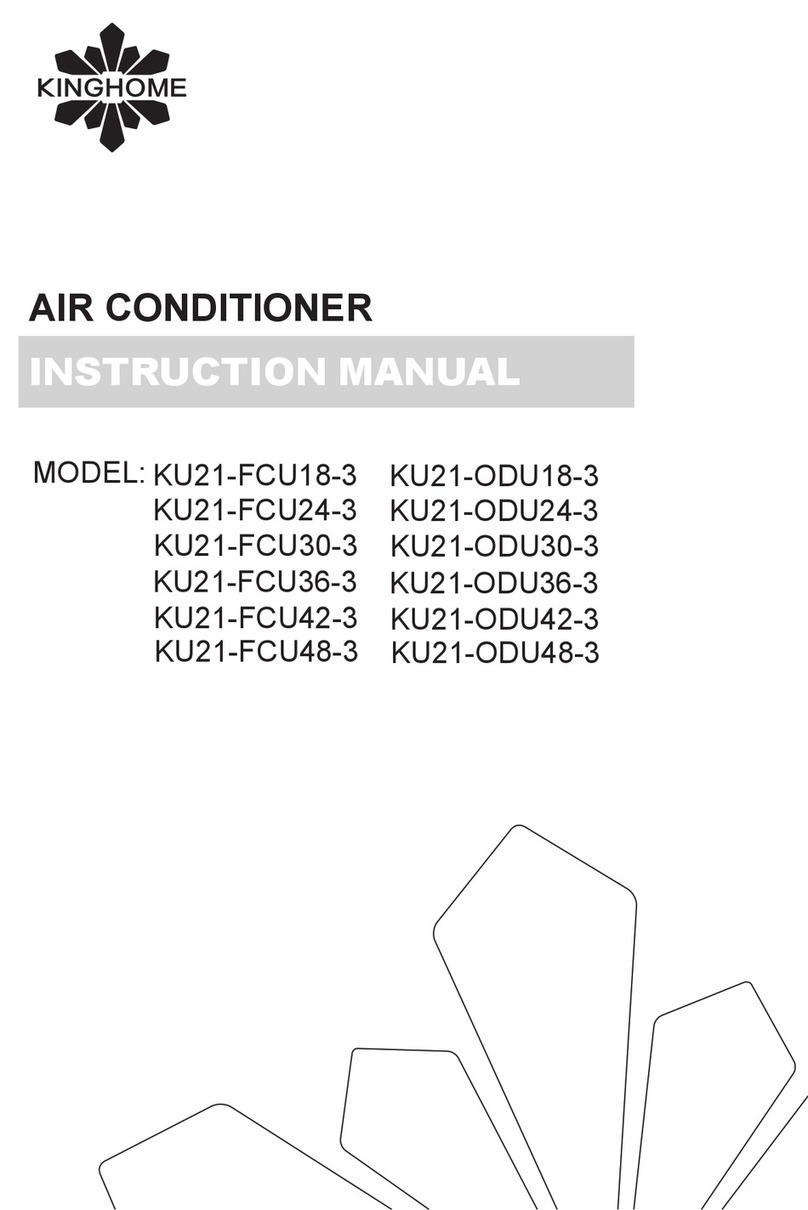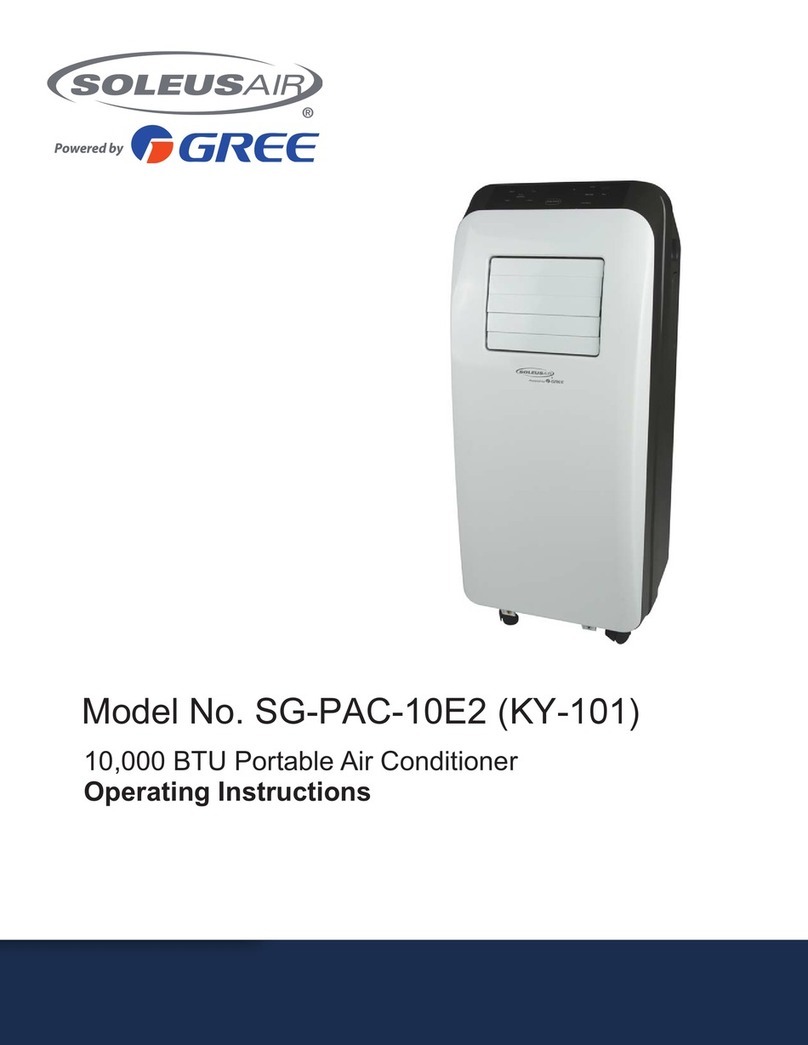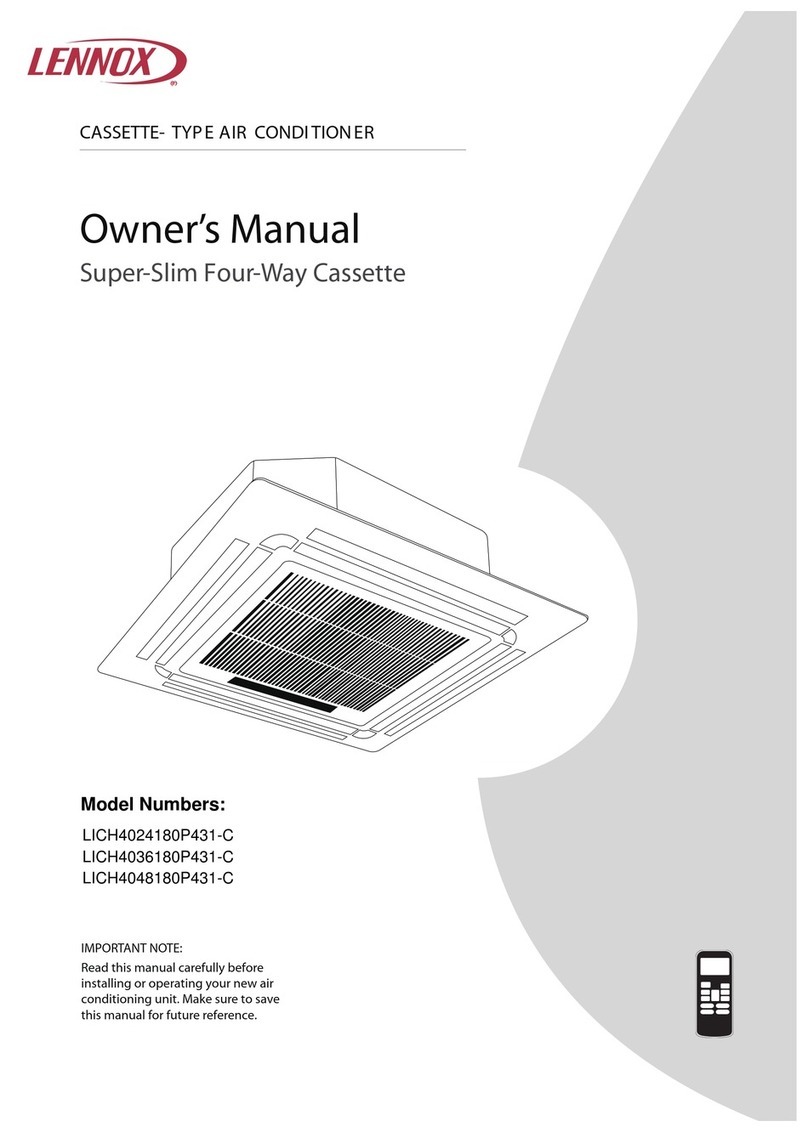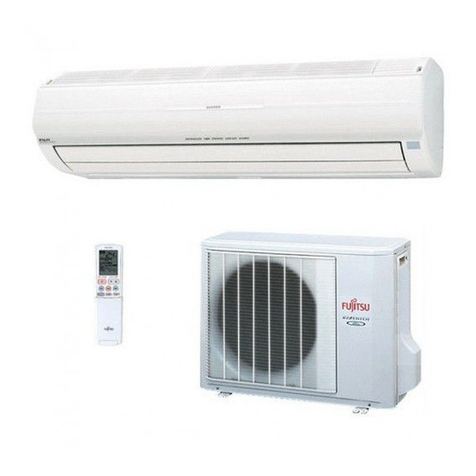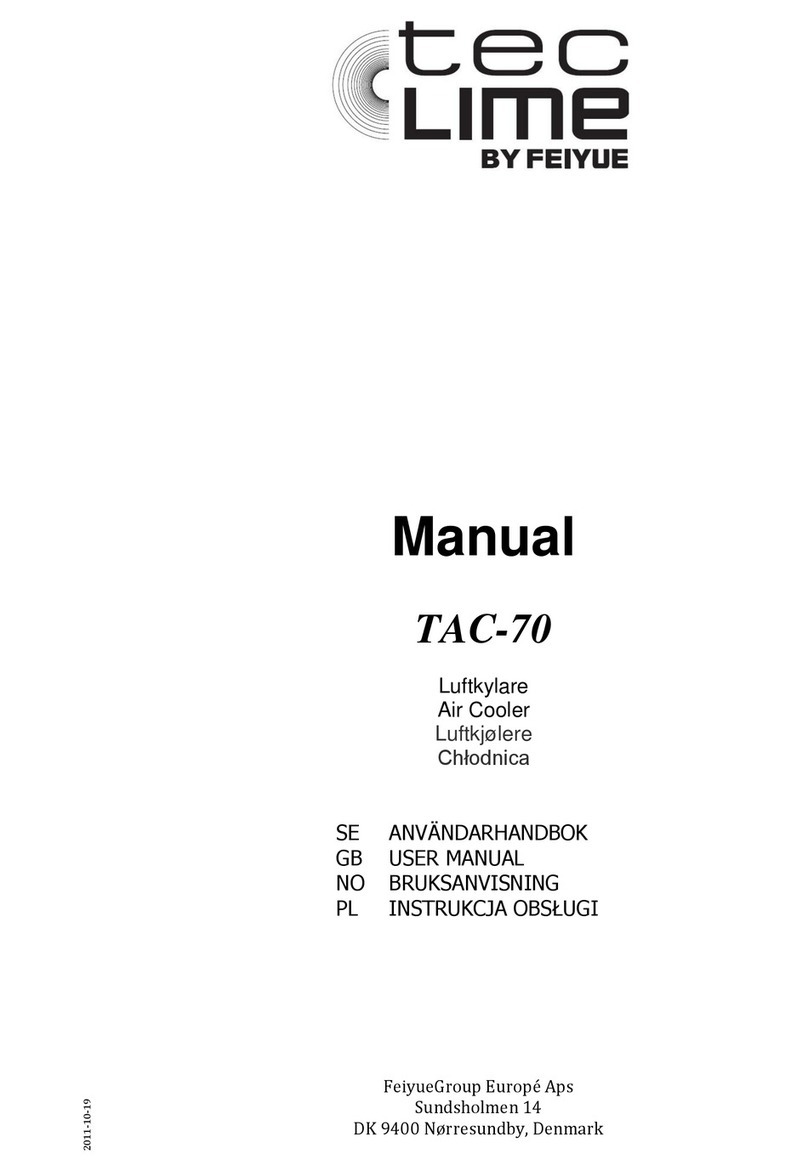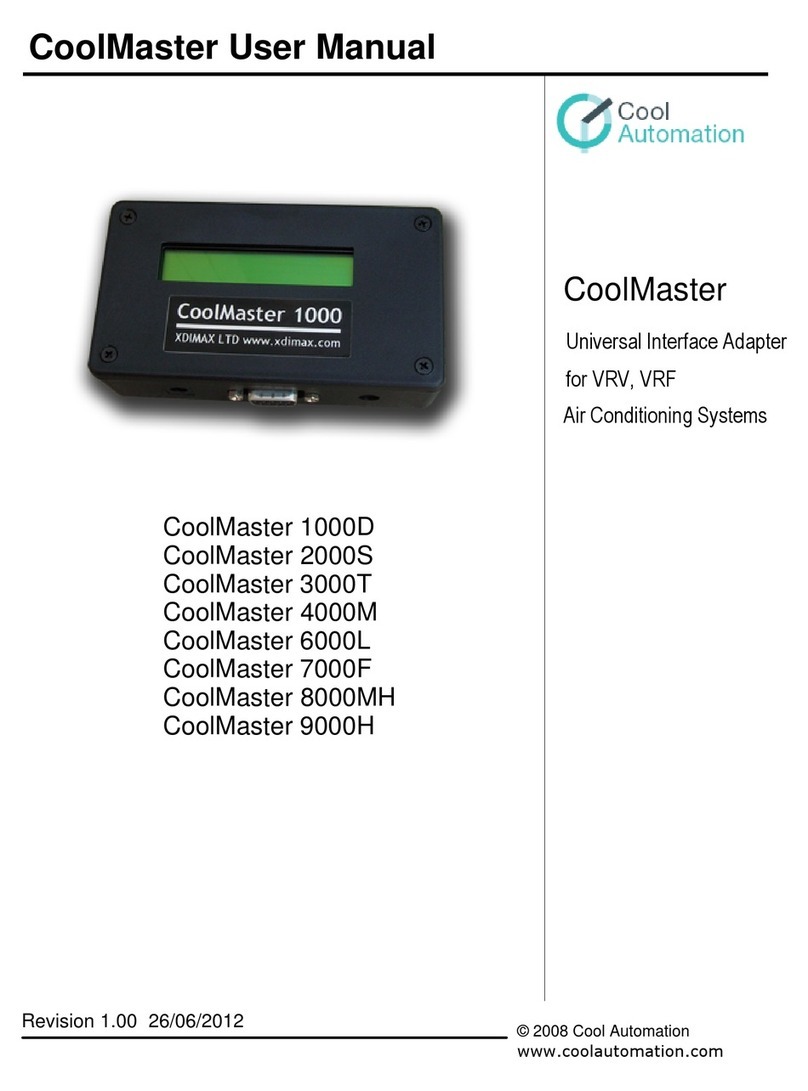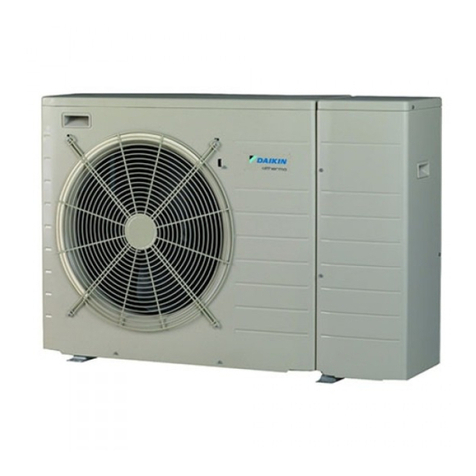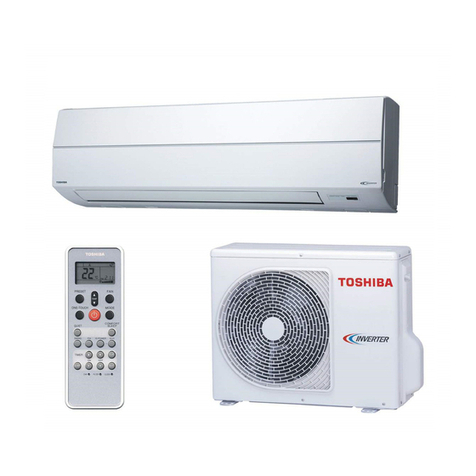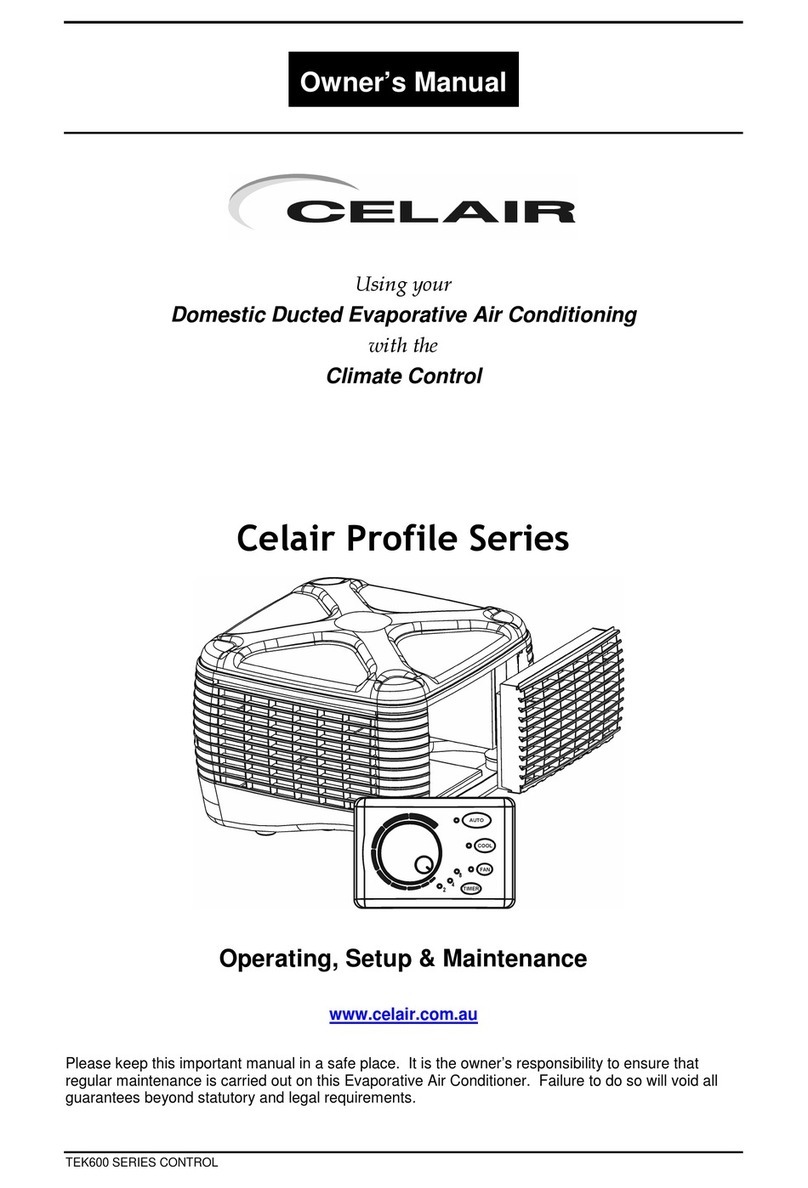Envicool DAICHI CyberMate Series User manual

CyberMate Series Air Conditioner
User Manual

Shenzhen Envicool Technology Co., Ltd.
2
CHAPTER 1 OVERVIEW...............................................................................................................................5
1.1 STANDARDS............................................................................................................................................. 5
1.2 APPLICATIONS..........................................................................................................................................5
1.3 MODEL DESCRIPTION.............................................................................................................................. 5
1.4 SYSTEM DIAGRAM....................................................................................................................................7
CHAPTER 2 ONSITE PREPARATION AND INSTALLATION................................................................ 8
2.1 PRECAUTIONS FOR INSTALLATION................................................................................................... 8
2.1.1 STORAGE AND OPERATION ENVIRONMENT REQUIREMENTS OF CYBERMATE SERIES AIR
CONDITIONER...........................................................................................................................................8
2.1.2 PREPARATION OF THE COMPUTER ROOM...................................................................................9
2.1.3 INSTALLATION SITE TIPS............................................................................................................... 9
2.2 MECHANICAL PARAMETERS............................................................................................................10
2.2.1 OUTLINE DIMENSIONS.................................................................................................................10
2.2.2 INSTALLATION AND MAINTENANCE SPACE REQUIREMENTS....................................................... 15
2.2.3 PACKAGE SIZE AND GROSS WEIGHT..........................................................................................18
2.3 INSPECTION OF INCOMING GOODS................................................................................................19
2.4 UNIT INSTALLATION........................................................................................................................ 19
2.4.1 UNIT FIXATION.............................................................................................................................19
2.4.2 SCHEMATIC DIAGRAM FOR SYSTEM INSTALLATION....................................................................21
2.4.3 PIPE CONNECTION AND REFRIGERANT REQUIREMENT............................................................. 23
2.4.4 REMOVAL OF COMPRESSOR FOOTER HOLDER.......................................................................... 28
2.4.5 ONSITE FIXATION OF FLOODING SENSOR.................................................................................. 29
2.4.6 ELECTRIC CONNECTION..............................................................................................................29
2.5 ITEMS FOR VERIFICATION WHEN THE INSTALLATION IS COMPLETED (CHECKLIST)...................... 36
CHAPTER 3 CONTROLLER.......................................................................................................................37
3.1 UNIT DISPLAY................................................................................................................................. 37
3.2 SYSTEM MENU STRUCTURE........................................................................................................... 37
3.2.1 SYSTEM STANDBY INTERFACE.....................................................................................................37
3.2.2 SYSTEM INITIALIZATION INTERFACE:...........................................................................................38
3.2.3 PASSWORD INPUT INTERFACE....................................................................................................38
3.2.4 NORMAL DISPLAY INTERFACE.....................................................................................................39
3.2.5 TIME SETTING..............................................................................................................................39
3.2.6 PARA SETTING.............................................................................................................................40
3.2.7 SYSTEM STATE.............................................................................................................................40
3.2.8 CURRENT ALARM........................................................................................................................ 41
3.2.9 HISTORY ALARM..........................................................................................................................42

Shenzhen Envicool Technology Co., Ltd.
3
3.2.10 TEMPERATURE/HUMIDITY CURVE..............................................................................................42
3.2.11 SHUTDOWN INTERFACE............................................................................................................ 43
CHAPTER 4 SYSTEM OPERATION......................................................................................................... 44
4.1 TEMPERATURE CONTROL............................................................................................................... 44
4.1.COOLING/REHEATING.................................................................................................................... 44
4.1.2 COOLING..................................................................................................................................... 44
4.1.3 HEATING...................................................................................................................................... 44
4.2 HUMIDITY CONTROL....................................................................................................................... 44
4.2.1 HUMIDIFYING............................................................................................................................... 44
4.3 SYSTEM PROTECTION..................................................................................................................... 45
4.4 COMMUNICATION............................................................................................................................45
CHAPTER 5 ALARM....................................................................................................................................46
5.1 ALARM:INTERPRETATION &TROUBLESHOOTING.......................................................................46
5.1.1 HIGH PRESSURE ALARM............................................................................................................. 46
5.1.2 LOW PRESSURE ALARM..............................................................................................................46
5.1.3 HUMIDITY.....................................................................................................................................47
5.1.4TEMPERATURE..............................................................................................................................47
5.1.5POWER SUPPLY............................................................................................................................47
5.1.6COMMUNICATION FAULT.............................................................................................................. 48
5.1.7SENSOR FAULT............................................................................................................................ 48
CHAPTER 6 SYSTEM TESTING AND MAINTENANCE........................................................................ 49
6.1 TEMPERATURE CONTROL............................................................................................................. 49
6.1.1COOLING...................................................................................................................................... 49
6.1.2HEATING....................................................................................................................................... 49
6.1.3HUMIDIFYING................................................................................................................................ 49
6.1.4FLOOR FLOODING DETECTION..................................................................................................... 49
6.1.5SHUT DOWN VIA REMOTE CONTROL............................................................................................ 49
6.2 MAINTENANCE................................................................................................................................ 50
6.2.1CIRCUIT BOARD............................................................................................................................50
6.2.2AIR FILTER.................................................................................................................................... 50
6.2.3 FAN..............................................................................................................................................51
6.2.4 COOLING SYSTEM....................................................................................................................... 51
6.2.5 HUMIDIFIER................................................................................................................................. 54
CHAPTER 7 MAINTENANCE INSPECTION CHECKLIST................................................................... 56

Shenzhen Envicool Technology Co., Ltd.
5
Chapter 1 Overview
1.1 Standards
CyberMate series air conditioners meet the GB/T 19413-2010 Unitary Air Conditioners for
Computer and Data Processing Room standard.
1.2 Applications
CyberMate series cooling units are dedicated unitary air-conditioning system developed for
Internet Date Center.
1.3 Model description
For the model description of the indoor units and outdoor units of the CyberMate DX series
air conditioners, please refer to Table 1-1 and Table 1-2 respectively.
Table 1-1 Model description of the indoor units of CyberMate series air conditioners
SN
Function
Code
Description
1
Series name
CyberMate
CyberMate CRAC cooling unit
2
Series code
6
DX Single compressor unit
3
Cooling
capacity code
0~999
For example: 020 represents 20kW
4
Function
B
Cooling function
H
Cooling and heating function
P
Cooling, heating and humidifying function
5
Fan type
I
AC fan
E
EC fan
6
Air outlet
condition
F
Downflow
S
Downflow with fans under floor
U
Upflow with plenum
D
Upflow with duct
7
Power system
1
380V 3Ph-50Hz
2
220V 1Ph-50Hz
3
Other power system
8
Cooling
method
A
Air cooled
F
Dual cycle: iFreecooling /air cooled
W
Water cooled

Shenzhen Envicool Technology Co., Ltd.
6
G
Glycol cooled
N
Integrated fresh air and evaporative cooling pad
C
Chilled water; single coil
T
Chilled water; double coil
D
Double cooling source: air cooled/chilled water
R
Double cooling source: water cooled (glycol cooled)/chilled water
9
Custom code
C
Containters of communication data centers
X
Custom function code
Table 1-2 Model description of the outdoor units of CyberMate series air conditioners
CyberMate60
16
E
C
CyberMate60 Outdoor
CRAC cooling unit
16 16.8kW refrigerating output
20 20.2kW refrigerating output
Outdoor unit
C:Standard
design
S:Quiet design

Shenzhen Envicool Technology Co., Ltd.
7
1.4 System diagram

Shenzhen Envicool Technology Co., Ltd.
8
Chapter 2 Onsite Preparation and Installation
2.1 Precautions for installation
Note
When handling the unit, you must keep the unit vertical. It is prohibited to handle the unit
horizontally or upside down. Any damage caused to the unit for failing to observe this
instruction shall not be covered by the warranty.
Before installing the equipment, you should decide how to modify the building to facilitate
the piping, cabling and duct construction. Please install the units strictly according to the
relevant drawings. For the reserved installation and maintenance space, please refer to the
engineering dimension drawing provided by the manufacturer.
2.1.1 Storage and operation environment requirements of CyberMate series air
conditioner
For the storage and operation environment requirements of the CyberMate series air
conditioner, please refer to Table 2-1 and Table 2-2.
Table 2-1 Storage environment requirement
Item
Requirement
Storage environment
Indoor, clean, dust free, etc
Ambient temperature
-40ºC~70ºC
Relative humidity
5%RH-90%RH
Storage time
The total transportation and storage time shall not exceed 6 months; otherwise, the
performance shall be recalibrated.
Table 2-2 Operation environment requirement
Item
Requirement

Shenzhen Envicool Technology Co., Ltd.
9
Installation mode
Indoor unit: vertical installation; Outdoor unit: vertical installation
Connecting pipe
length (DX unit)
Maximum equivalent length for indoor/outdoor unit (horizontal): 60m; extension
component shall be configured when the length exceeds 30m.
Drop height (DX unit)
Maximum drop height when the outdoor unit is above the indoor unit (positive drop
height): 20m; extension component shall be configured when the drop height exceeds
10m.
Maximum drop height when the outdoor unit is below the indoor unit (negative drop
height): -5m
Indoor ambient
temperature
0ºC~45ºC
Outdoor ambient
temperature
Standard configuration: -15ºC~45ºC; Low temperature kits configured: -40ºC~45ºC
Relative humidity
20%RH~80%RH
IP class of outdoor
unit
IPX4
Altitude
<1000m, derated when the altitude exceeds 1000m
Operating voltage
range
Three-phase power supply: 380V(-15%~+15%), deviation 3%
Note: If the relevant values in the actual application exceed the recommended values
in the above tables, please consult the technical department of our company.
2.1.2 Preparation of the computer room
Computer room shall have good insulation and a sealed moisture-proof layer. Ceilings and
walls shall be equipped with sealed moisture-proof layers.
The computer room shall minimize the entry of outdoor air, which will increase the cooling,
reheating and humidification load of the system. Therefore, it is suggested that the amount of
outdoor air intake shall below 5% of the total amount of indoor circulated air. All doors shall be
fully sealed and the sealed gap of the door shall be as small as possible.
2.1.3 Installation site tips
Warning
Since the equipment can generate condensate water, the lower precise equipment may be
damaged due to water leakage. Do not install the air conditioner above the precise equipment.
Drainage pipelines shall be provided at the installation site of the equipment, which will be
installed below the indoor unit.
To ensure the normal operation of the indoor unit, you shall try to select a spacious area as the
installation site of the indoor unit. Avoid placing it in a narrow place; otherwise it will affect the
air flow organization, resulting in air intake and return air short circuit and air noise. Avoid
placing it at the end of a recess or a long and narrow room. Avoid installing multiple units one

Shenzhen Envicool Technology Co., Ltd.
10
next to another closely, which can cause overlapped air supply flow between different units,
unbalanced load and the mode that heating and refrigeration of different units compete for
operation simultaneously. Do not add extra devices to the case (such as the smoke detector),
which will hinder daily maintenance and repair.
The schematic diagram of the air conditioning equipment installation location is shown in
Figure 2-1.
Fig.2-1 Installation position of CRAC
2.2 Mechanical parameters
Warning
You must strictly comply with the recommended installation and maintenance space
requirement of the relevant equipment.
You should decide whether to modify the building to facilitate the piping, cabling and duct
construction.
2.2.1 Outline dimensions
For the outline dimensions of the unit, please refer to Fig.2-1 and Fig.2-2, Table 2-3.

Shenzhen Envicool Technology Co., Ltd.
11
Outline dimensions of CyberMate6005~6020 upflow series indoor and outdoor unit are seen in
Fig.2-1.
Fig.2-1(a) Outline Dimensions of indoor units of the upflow CyberMate6005/6007/6012

Shenzhen Envicool Technology Co., Ltd.
12
Fig.2-1 (b)Outline Dimensions of indoor units of the upflow CyberMate6016/6020
Outline Dimensions of indoor units of the downflow CyberMate6005~6020 are seen in Fig.2-2.

Shenzhen Envicool Technology Co., Ltd.
13
Fig.2-2 (a)Outline Dimensions of indoor units of the downflow CyberMate6005/6007/6012
Table 2-3 Outline Dimensions of the indoor units of CyberMate6016/6020
Model
A
B
C
CyberMate6005/6007/6012
600
550
1900
CyberMate6016/6020
750
750
1950

Shenzhen Envicool Technology Co., Ltd.
14
CyberMate6005EC/6007 EC CyberMate6012EC
CyberMate6016EC CyberMate6020EC
Fig.2-2 Outline Dimensions of the outdoor units of the CyberMate6005~6020

Shenzhen Envicool Technology Co., Ltd.
15
2.2.2 Installation and maintenance space requirements
When reserving the installation and maintenance space, the pipe connecting and front
access space shall be considered. The maintenance and heat dissipation requirement of
the compressor shall also be taken into consideration for the outdoor unit.
For the installation and maintenance space requirements of the indoor/outdoor units of the
CyberMate series air conditioner, please refer to Fig.2-3/ Fig.2-4and Table2-5.
≥
≥
≥
≥
Fig.2-3(a) Schematic diagram for the installation and maintenance space of the indoor unit of the upflow
CyberMate6005~6020

Shenzhen Envicool Technology Co., Ltd.
16
≥
≥
≥
≥
Fig.2-3(b) Schematic diagram for the installation and maintenance space of the indoor unit of the
downflow CyberMate6005~6020
Fig.2-4(a) Schematic diagram for the installation and maintenance space of the outdoor unit of the
CyberMate6005/6008

Shenzhen Envicool Technology Co., Ltd.
17
Fig.2-4(b) Schematic diagram for the installation and maintenance space of the outdoor unit of the
CyberMate6012
Fig.2-4(c) Schematic diagram for the installation and maintenance space of the outdoor unit of the
CyberMate6016

Shenzhen Envicool Technology Co., Ltd.
18
Fig.2-4(d) Schematic diagram for the installation and maintenance space of the outdoor unit of the
CyberMate6020
Note
1. The installation and maintenance space diagram of the indoor unit of the
CyberMate series upper/lower air supply series is for reference only. The
actual installation shall prevail.
2.2.3 Package size and gross weight
The package size and gross weight of different models are listed in Table 2-4.
Table 2-4 Package size and gross weight of different models
Model
Package size (L×W×H, mm)
Gross
weight (kg)
indoor unit
CyberMate6005/6007
746×636×2060
120/130
CyberMate6012
746×636×2060
150
CyberMate6016
896×836×2150
280
CyberMate6020
896×836×2150
300
outdoor unit
CyberMate6005/6007EC
916×471×950
45
CyberMate6012EC
916×471×1400
60
CyberMate6016EC
1626×471×1400
100
CyberMate6020EC
1626×471×1400
110

Shenzhen Envicool Technology Co., Ltd.
19
2.3 Inspection of incoming goods
When possible, the equipment shall be transported to the place nearest to the final
installation site before unpacking. All the components are separately packaged before
they are packed into the box for delivery. When receiving the CyberMate series
products, you shall check their appearance to see whether all the components are
intact. When any damage is found upon unpacking inspection, report to the
transportation agent immediately. If any hidden damage is found, please report to the
transportation agent and Envicool.
2.4 Unit Installation
2.4.1 Unit fixation
2.4.1.1 Fixation of outdoor unit
Remove the cabinet handling pallet of the outdoor unit and fix the outdoor unit reliably
to the outdoor ground with the expansion bolt. The outdoor unit must be placed at the
position where safety and convenient maintenance can be ensured. Do not place the
outdoor unit at the first floor of the public site.
To ensure the proper heat dissipation, the outdoor unit shall be installed horizontally at
the clean place and free from any dust or foreign object, because they may block the
coil. The outdoor unit cannot be installed near the steam, hot air or hot exhaust gas. A
clearance of at least 400mm shall be maintained between the outdoor unit and the
wall, obstacle or adjacent equipment. The equipment shall not be installed at the place
where the snow may accumulate at the air inlet and outlet.
2.4.1.2 Fixation and connection of indoor unit
Dismantled the handling trays of indoor unit , and securely fixed the indoor unit on the
ground or stand.In order to ensure the normal operation of the unit, the entire unit must
be level.
Base stand can be made by Channel.User can mounting brackets refer to Fig 2-5.

Shenzhen Envicool Technology Co., Ltd.
20
Fig 2-5 (a) Base stand of CyberMate6005/6007/6012
Fig 2-5 (b) Base stand of CyberMate6016/6020
Table 2-5 Installation base size of the indoor unit
Item
Requirement
Remark
Angle iron
40mm×40mm×3mm
/
Anti-shock rubber
pads
Upper part
Thickness:3.0mm
Rubber pads is
Vertically symmetrical
Bottom part
Thickness:3.0mm
This manual suits for next models
10
Table of contents
Other Envicool Air Conditioner manuals
Popular Air Conditioner manuals by other brands

Mitsubishi Electric
Mitsubishi Electric Mr.Slim MUZ-GE09NA Service manual
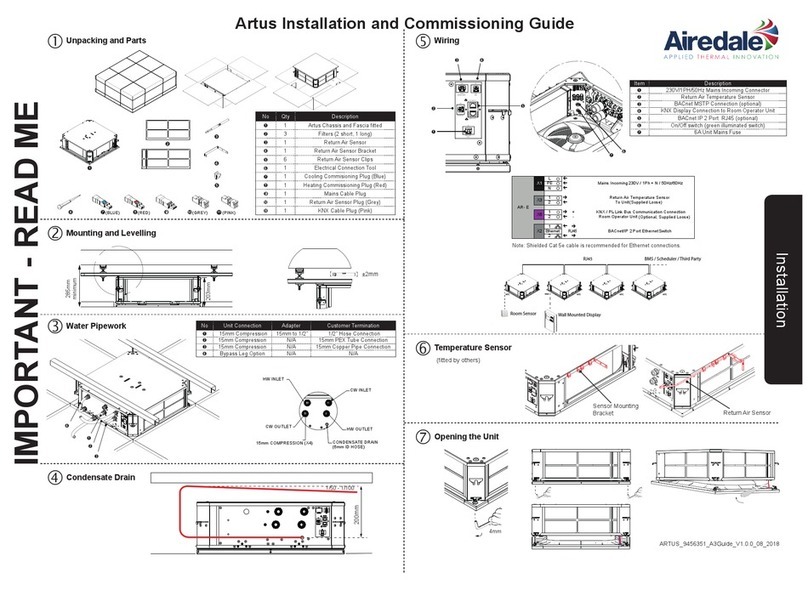
AIREDALE
AIREDALE Artus Installation and commissioning guide

Boreal
Boreal Brisa MBRS42HPJ1OA owner's manual
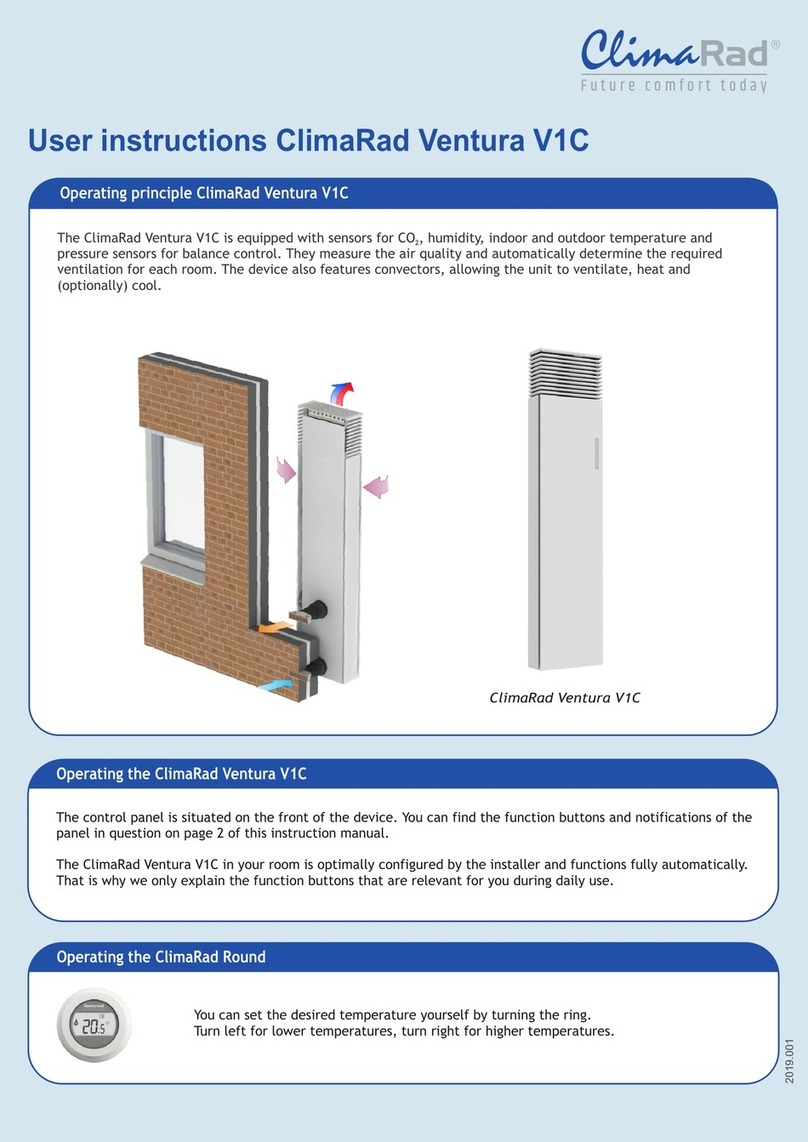
ClimaRad
ClimaRad Ventura V1C User instructions
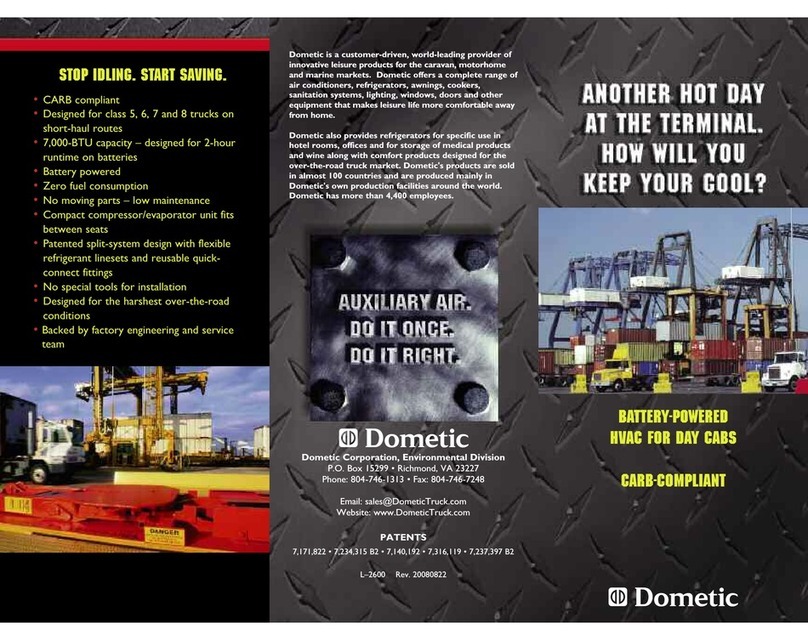
Dometic
Dometic Battery-powered HVAC For Day Cabs brochure

Mitsubishi Electric
Mitsubishi Electric MSZ-GL18NA operating instructions



